BUS105 Essay: Reconciling Cultural Differences in a Global World
VerifiedAdded on 2022/08/31
|8
|2080
|19
Essay
AI Summary
This essay examines the potential for reconciliation between people from different cultures, arguing that recognizing and respecting cultural diversity is crucial for successful outcomes in organizations. It explores the complexity and diversity of culture, including underlying assumptions, norms, and artifacts. The essay discusses the advantages of cultural diversity, such as increased flexibility and awareness of consumer needs, while also acknowledging challenges like conflicting working styles and communication barriers. It further analyzes how culture affects marketing strategies, emphasizing the importance of understanding cultural nuances in brand identification and marketing campaigns. The essay highlights the role of cross-culture management in addressing global challenges and fostering creativity and employee engagement within organizations. It concludes that by embracing cultural differences, businesses can revolutionize marketing and operations, leading to a more harmonious and productive global environment.
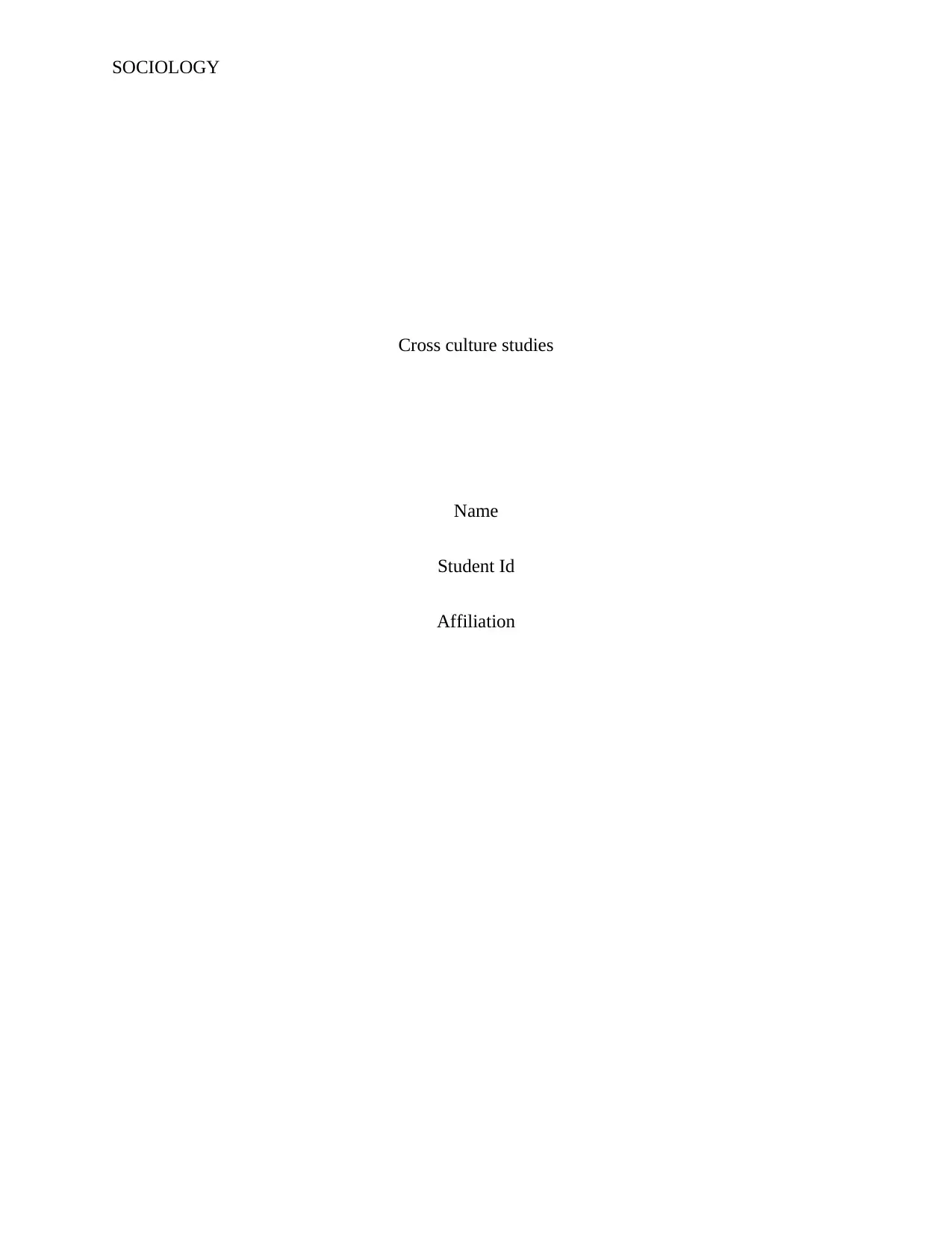
SOCIOLOGY
Cross culture studies
Name
Student Id
Affiliation
Cross culture studies
Name
Student Id
Affiliation
Paraphrase This Document
Need a fresh take? Get an instant paraphrase of this document with our AI Paraphraser
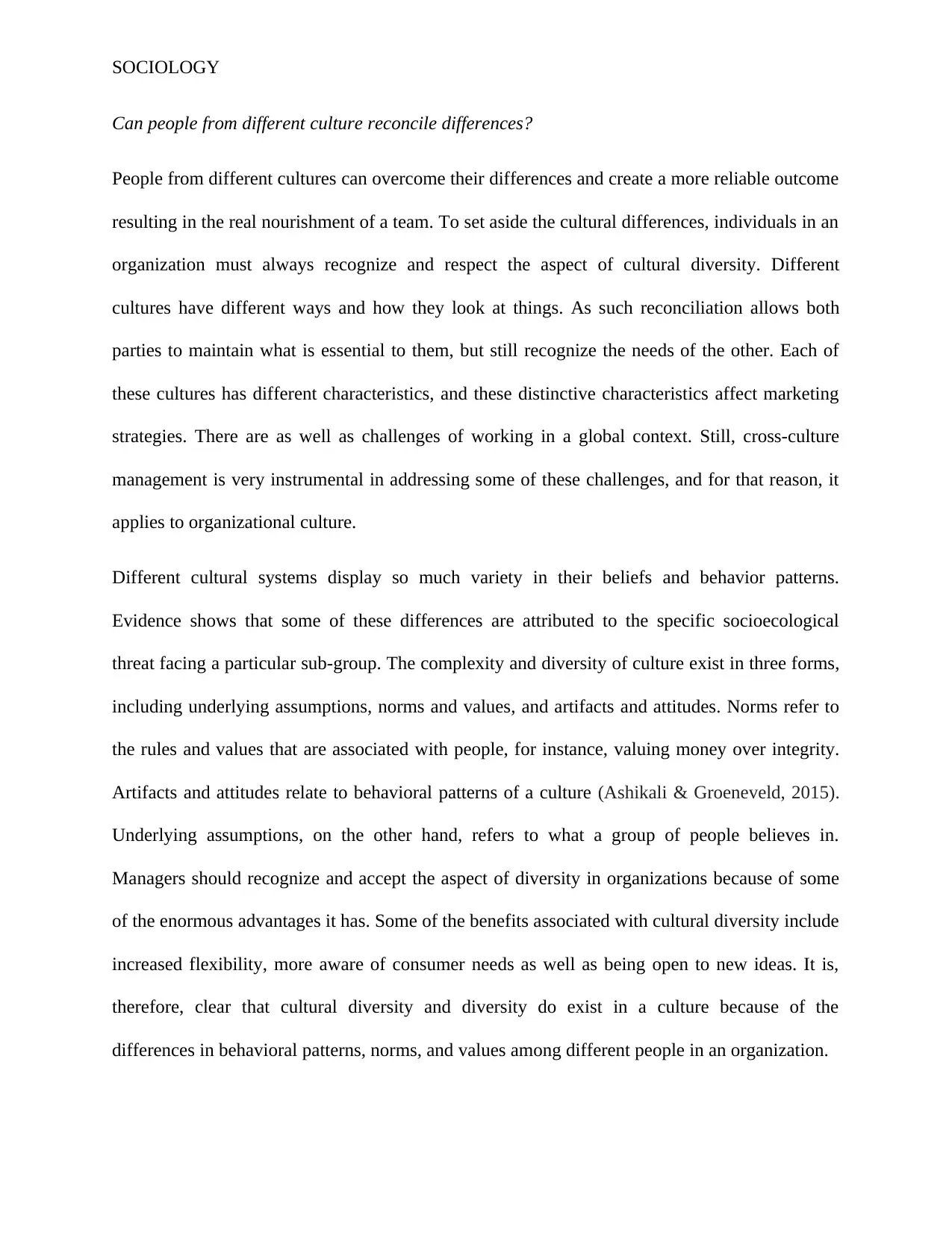
SOCIOLOGY
Can people from different culture reconcile differences?
People from different cultures can overcome their differences and create a more reliable outcome
resulting in the real nourishment of a team. To set aside the cultural differences, individuals in an
organization must always recognize and respect the aspect of cultural diversity. Different
cultures have different ways and how they look at things. As such reconciliation allows both
parties to maintain what is essential to them, but still recognize the needs of the other. Each of
these cultures has different characteristics, and these distinctive characteristics affect marketing
strategies. There are as well as challenges of working in a global context. Still, cross-culture
management is very instrumental in addressing some of these challenges, and for that reason, it
applies to organizational culture.
Different cultural systems display so much variety in their beliefs and behavior patterns.
Evidence shows that some of these differences are attributed to the specific socioecological
threat facing a particular sub-group. The complexity and diversity of culture exist in three forms,
including underlying assumptions, norms and values, and artifacts and attitudes. Norms refer to
the rules and values that are associated with people, for instance, valuing money over integrity.
Artifacts and attitudes relate to behavioral patterns of a culture (Ashikali & Groeneveld, 2015).
Underlying assumptions, on the other hand, refers to what a group of people believes in.
Managers should recognize and accept the aspect of diversity in organizations because of some
of the enormous advantages it has. Some of the benefits associated with cultural diversity include
increased flexibility, more aware of consumer needs as well as being open to new ideas. It is,
therefore, clear that cultural diversity and diversity do exist in a culture because of the
differences in behavioral patterns, norms, and values among different people in an organization.
Can people from different culture reconcile differences?
People from different cultures can overcome their differences and create a more reliable outcome
resulting in the real nourishment of a team. To set aside the cultural differences, individuals in an
organization must always recognize and respect the aspect of cultural diversity. Different
cultures have different ways and how they look at things. As such reconciliation allows both
parties to maintain what is essential to them, but still recognize the needs of the other. Each of
these cultures has different characteristics, and these distinctive characteristics affect marketing
strategies. There are as well as challenges of working in a global context. Still, cross-culture
management is very instrumental in addressing some of these challenges, and for that reason, it
applies to organizational culture.
Different cultural systems display so much variety in their beliefs and behavior patterns.
Evidence shows that some of these differences are attributed to the specific socioecological
threat facing a particular sub-group. The complexity and diversity of culture exist in three forms,
including underlying assumptions, norms and values, and artifacts and attitudes. Norms refer to
the rules and values that are associated with people, for instance, valuing money over integrity.
Artifacts and attitudes relate to behavioral patterns of a culture (Ashikali & Groeneveld, 2015).
Underlying assumptions, on the other hand, refers to what a group of people believes in.
Managers should recognize and accept the aspect of diversity in organizations because of some
of the enormous advantages it has. Some of the benefits associated with cultural diversity include
increased flexibility, more aware of consumer needs as well as being open to new ideas. It is,
therefore, clear that cultural diversity and diversity do exist in a culture because of the
differences in behavioral patterns, norms, and values among different people in an organization.
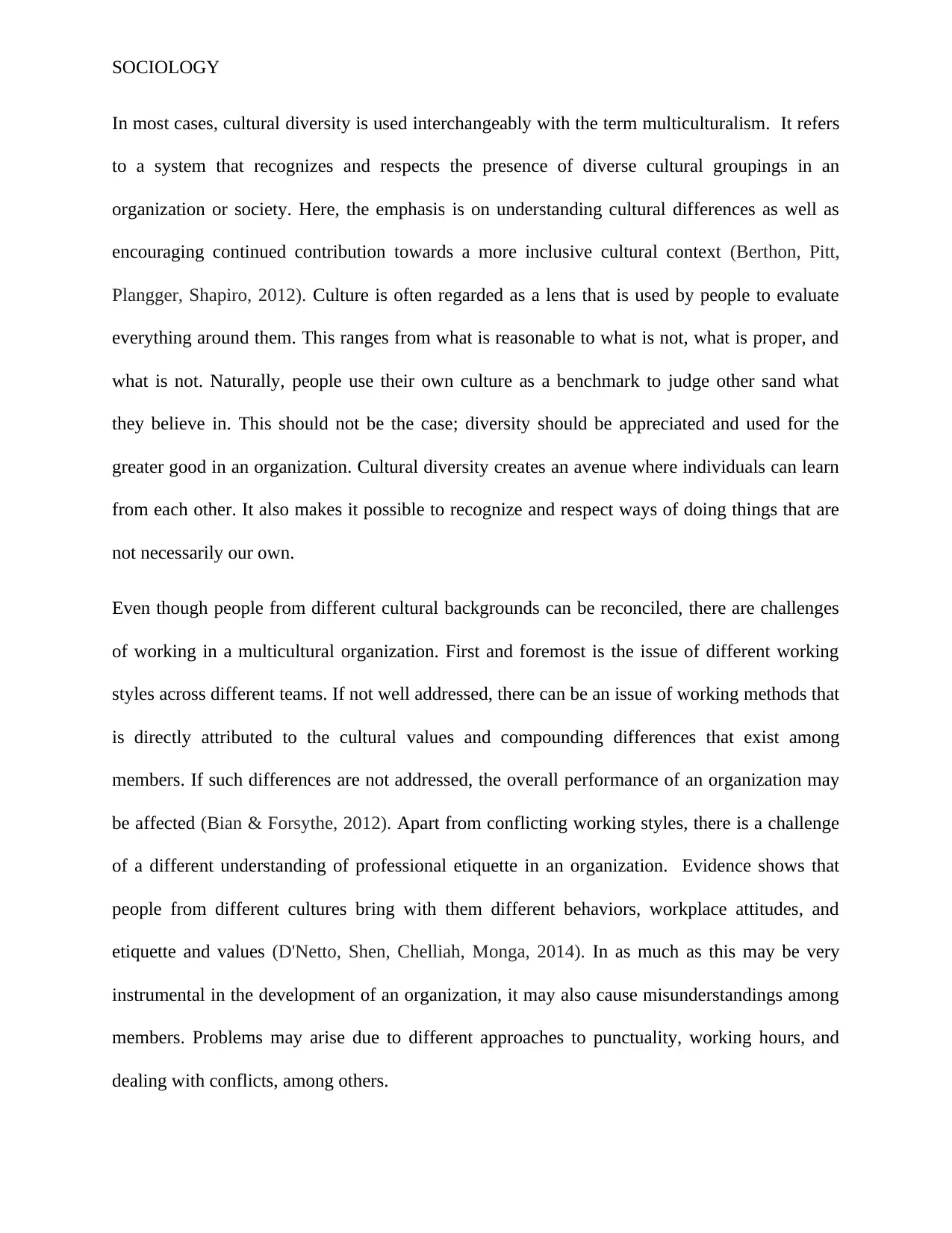
SOCIOLOGY
In most cases, cultural diversity is used interchangeably with the term multiculturalism. It refers
to a system that recognizes and respects the presence of diverse cultural groupings in an
organization or society. Here, the emphasis is on understanding cultural differences as well as
encouraging continued contribution towards a more inclusive cultural context (Berthon, Pitt,
Plangger, Shapiro, 2012). Culture is often regarded as a lens that is used by people to evaluate
everything around them. This ranges from what is reasonable to what is not, what is proper, and
what is not. Naturally, people use their own culture as a benchmark to judge other sand what
they believe in. This should not be the case; diversity should be appreciated and used for the
greater good in an organization. Cultural diversity creates an avenue where individuals can learn
from each other. It also makes it possible to recognize and respect ways of doing things that are
not necessarily our own.
Even though people from different cultural backgrounds can be reconciled, there are challenges
of working in a multicultural organization. First and foremost is the issue of different working
styles across different teams. If not well addressed, there can be an issue of working methods that
is directly attributed to the cultural values and compounding differences that exist among
members. If such differences are not addressed, the overall performance of an organization may
be affected (Bian & Forsythe, 2012). Apart from conflicting working styles, there is a challenge
of a different understanding of professional etiquette in an organization. Evidence shows that
people from different cultures bring with them different behaviors, workplace attitudes, and
etiquette and values (D'Netto, Shen, Chelliah, Monga, 2014). In as much as this may be very
instrumental in the development of an organization, it may also cause misunderstandings among
members. Problems may arise due to different approaches to punctuality, working hours, and
dealing with conflicts, among others.
In most cases, cultural diversity is used interchangeably with the term multiculturalism. It refers
to a system that recognizes and respects the presence of diverse cultural groupings in an
organization or society. Here, the emphasis is on understanding cultural differences as well as
encouraging continued contribution towards a more inclusive cultural context (Berthon, Pitt,
Plangger, Shapiro, 2012). Culture is often regarded as a lens that is used by people to evaluate
everything around them. This ranges from what is reasonable to what is not, what is proper, and
what is not. Naturally, people use their own culture as a benchmark to judge other sand what
they believe in. This should not be the case; diversity should be appreciated and used for the
greater good in an organization. Cultural diversity creates an avenue where individuals can learn
from each other. It also makes it possible to recognize and respect ways of doing things that are
not necessarily our own.
Even though people from different cultural backgrounds can be reconciled, there are challenges
of working in a multicultural organization. First and foremost is the issue of different working
styles across different teams. If not well addressed, there can be an issue of working methods that
is directly attributed to the cultural values and compounding differences that exist among
members. If such differences are not addressed, the overall performance of an organization may
be affected (Bian & Forsythe, 2012). Apart from conflicting working styles, there is a challenge
of a different understanding of professional etiquette in an organization. Evidence shows that
people from different cultures bring with them different behaviors, workplace attitudes, and
etiquette and values (D'Netto, Shen, Chelliah, Monga, 2014). In as much as this may be very
instrumental in the development of an organization, it may also cause misunderstandings among
members. Problems may arise due to different approaches to punctuality, working hours, and
dealing with conflicts, among others.
⊘ This is a preview!⊘
Do you want full access?
Subscribe today to unlock all pages.

Trusted by 1+ million students worldwide
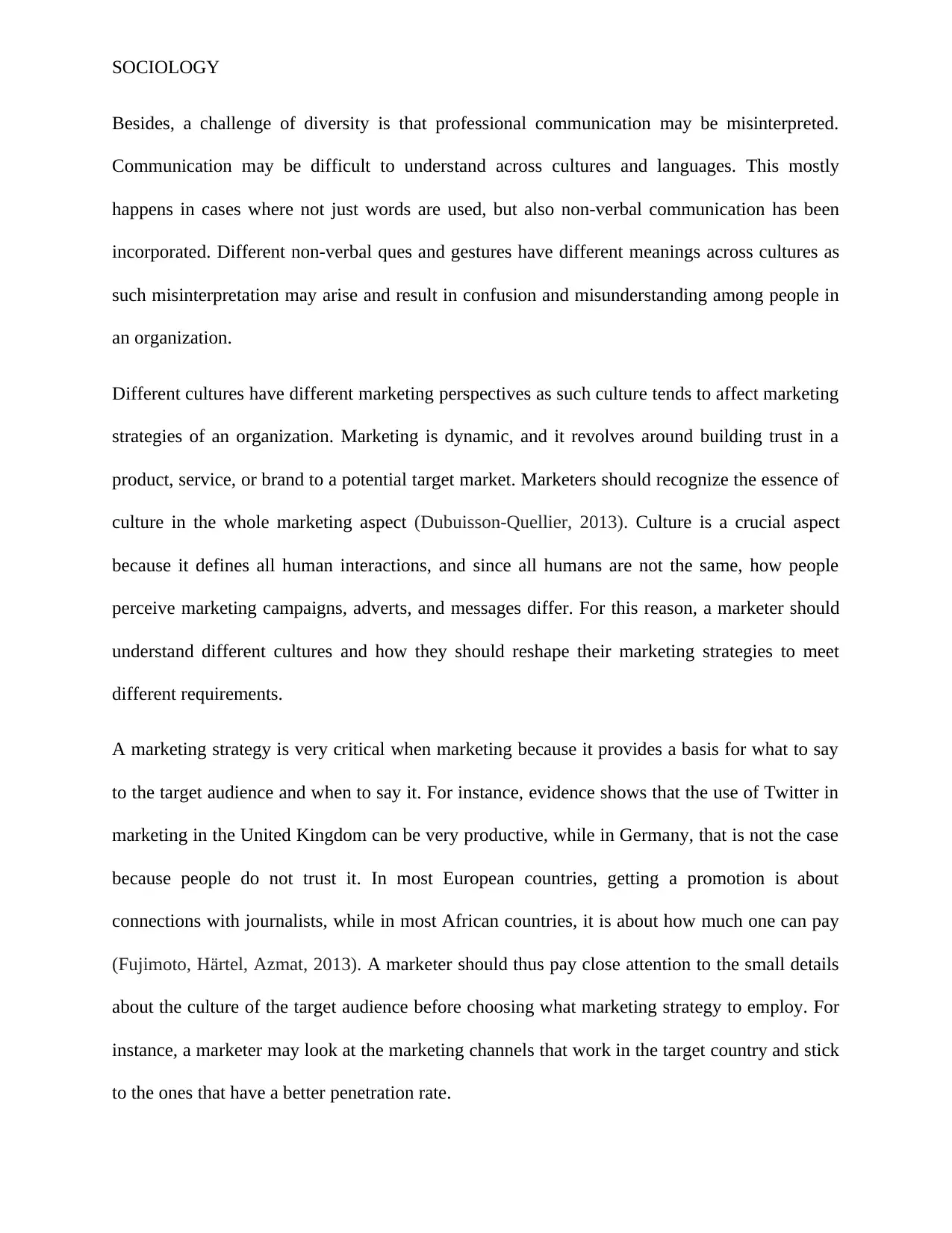
SOCIOLOGY
Besides, a challenge of diversity is that professional communication may be misinterpreted.
Communication may be difficult to understand across cultures and languages. This mostly
happens in cases where not just words are used, but also non-verbal communication has been
incorporated. Different non-verbal ques and gestures have different meanings across cultures as
such misinterpretation may arise and result in confusion and misunderstanding among people in
an organization.
Different cultures have different marketing perspectives as such culture tends to affect marketing
strategies of an organization. Marketing is dynamic, and it revolves around building trust in a
product, service, or brand to a potential target market. Marketers should recognize the essence of
culture in the whole marketing aspect (Dubuisson-Quellier, 2013). Culture is a crucial aspect
because it defines all human interactions, and since all humans are not the same, how people
perceive marketing campaigns, adverts, and messages differ. For this reason, a marketer should
understand different cultures and how they should reshape their marketing strategies to meet
different requirements.
A marketing strategy is very critical when marketing because it provides a basis for what to say
to the target audience and when to say it. For instance, evidence shows that the use of Twitter in
marketing in the United Kingdom can be very productive, while in Germany, that is not the case
because people do not trust it. In most European countries, getting a promotion is about
connections with journalists, while in most African countries, it is about how much one can pay
(Fujimoto, Härtel, Azmat, 2013). A marketer should thus pay close attention to the small details
about the culture of the target audience before choosing what marketing strategy to employ. For
instance, a marketer may look at the marketing channels that work in the target country and stick
to the ones that have a better penetration rate.
Besides, a challenge of diversity is that professional communication may be misinterpreted.
Communication may be difficult to understand across cultures and languages. This mostly
happens in cases where not just words are used, but also non-verbal communication has been
incorporated. Different non-verbal ques and gestures have different meanings across cultures as
such misinterpretation may arise and result in confusion and misunderstanding among people in
an organization.
Different cultures have different marketing perspectives as such culture tends to affect marketing
strategies of an organization. Marketing is dynamic, and it revolves around building trust in a
product, service, or brand to a potential target market. Marketers should recognize the essence of
culture in the whole marketing aspect (Dubuisson-Quellier, 2013). Culture is a crucial aspect
because it defines all human interactions, and since all humans are not the same, how people
perceive marketing campaigns, adverts, and messages differ. For this reason, a marketer should
understand different cultures and how they should reshape their marketing strategies to meet
different requirements.
A marketing strategy is very critical when marketing because it provides a basis for what to say
to the target audience and when to say it. For instance, evidence shows that the use of Twitter in
marketing in the United Kingdom can be very productive, while in Germany, that is not the case
because people do not trust it. In most European countries, getting a promotion is about
connections with journalists, while in most African countries, it is about how much one can pay
(Fujimoto, Härtel, Azmat, 2013). A marketer should thus pay close attention to the small details
about the culture of the target audience before choosing what marketing strategy to employ. For
instance, a marketer may look at the marketing channels that work in the target country and stick
to the ones that have a better penetration rate.
Paraphrase This Document
Need a fresh take? Get an instant paraphrase of this document with our AI Paraphraser
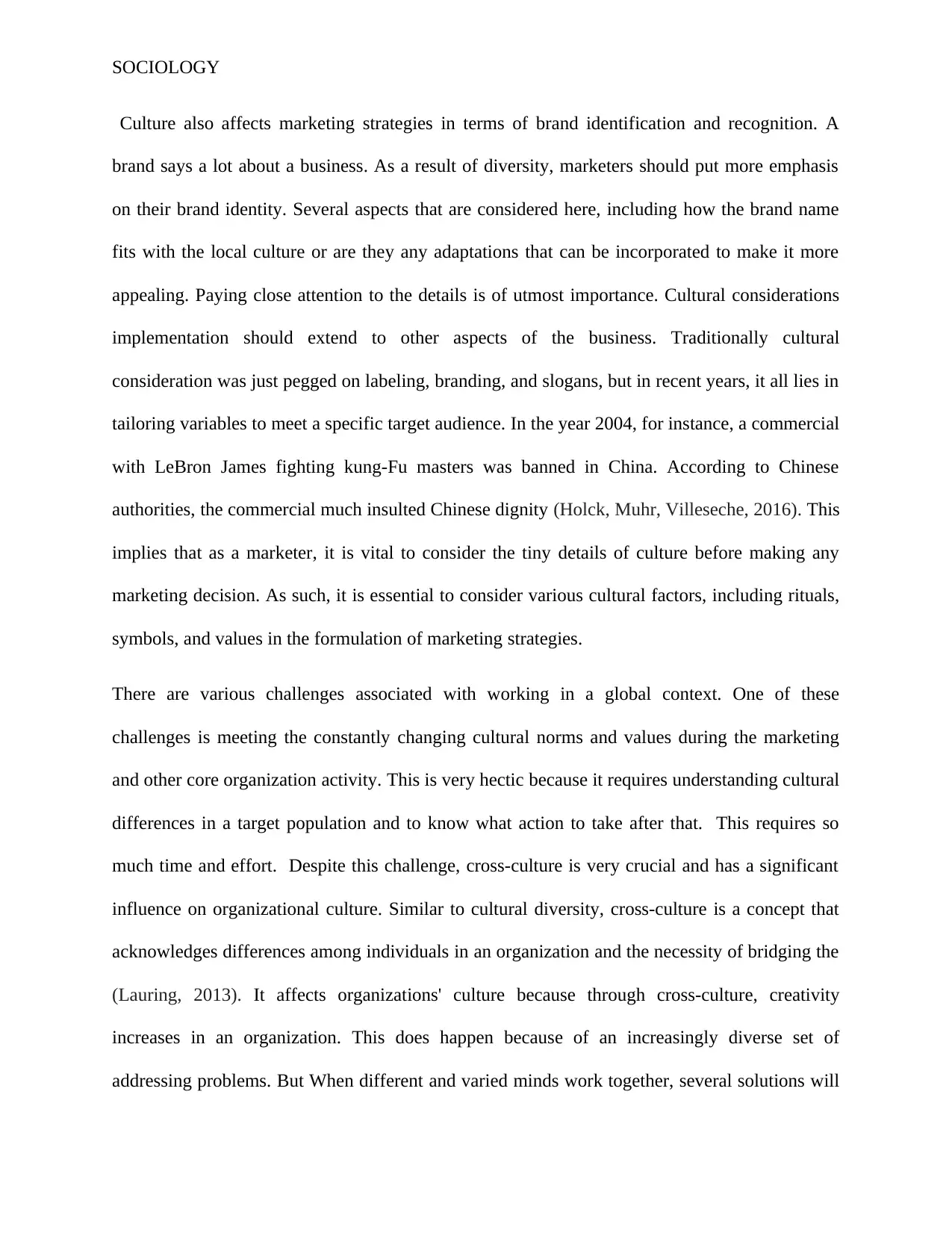
SOCIOLOGY
Culture also affects marketing strategies in terms of brand identification and recognition. A
brand says a lot about a business. As a result of diversity, marketers should put more emphasis
on their brand identity. Several aspects that are considered here, including how the brand name
fits with the local culture or are they any adaptations that can be incorporated to make it more
appealing. Paying close attention to the details is of utmost importance. Cultural considerations
implementation should extend to other aspects of the business. Traditionally cultural
consideration was just pegged on labeling, branding, and slogans, but in recent years, it all lies in
tailoring variables to meet a specific target audience. In the year 2004, for instance, a commercial
with LeBron James fighting kung-Fu masters was banned in China. According to Chinese
authorities, the commercial much insulted Chinese dignity (Holck, Muhr, Villeseche, 2016). This
implies that as a marketer, it is vital to consider the tiny details of culture before making any
marketing decision. As such, it is essential to consider various cultural factors, including rituals,
symbols, and values in the formulation of marketing strategies.
There are various challenges associated with working in a global context. One of these
challenges is meeting the constantly changing cultural norms and values during the marketing
and other core organization activity. This is very hectic because it requires understanding cultural
differences in a target population and to know what action to take after that. This requires so
much time and effort. Despite this challenge, cross-culture is very crucial and has a significant
influence on organizational culture. Similar to cultural diversity, cross-culture is a concept that
acknowledges differences among individuals in an organization and the necessity of bridging the
(Lauring, 2013). It affects organizations' culture because through cross-culture, creativity
increases in an organization. This does happen because of an increasingly diverse set of
addressing problems. But When different and varied minds work together, several solutions will
Culture also affects marketing strategies in terms of brand identification and recognition. A
brand says a lot about a business. As a result of diversity, marketers should put more emphasis
on their brand identity. Several aspects that are considered here, including how the brand name
fits with the local culture or are they any adaptations that can be incorporated to make it more
appealing. Paying close attention to the details is of utmost importance. Cultural considerations
implementation should extend to other aspects of the business. Traditionally cultural
consideration was just pegged on labeling, branding, and slogans, but in recent years, it all lies in
tailoring variables to meet a specific target audience. In the year 2004, for instance, a commercial
with LeBron James fighting kung-Fu masters was banned in China. According to Chinese
authorities, the commercial much insulted Chinese dignity (Holck, Muhr, Villeseche, 2016). This
implies that as a marketer, it is vital to consider the tiny details of culture before making any
marketing decision. As such, it is essential to consider various cultural factors, including rituals,
symbols, and values in the formulation of marketing strategies.
There are various challenges associated with working in a global context. One of these
challenges is meeting the constantly changing cultural norms and values during the marketing
and other core organization activity. This is very hectic because it requires understanding cultural
differences in a target population and to know what action to take after that. This requires so
much time and effort. Despite this challenge, cross-culture is very crucial and has a significant
influence on organizational culture. Similar to cultural diversity, cross-culture is a concept that
acknowledges differences among individuals in an organization and the necessity of bridging the
(Lauring, 2013). It affects organizations' culture because through cross-culture, creativity
increases in an organization. This does happen because of an increasingly diverse set of
addressing problems. But When different and varied minds work together, several solutions will
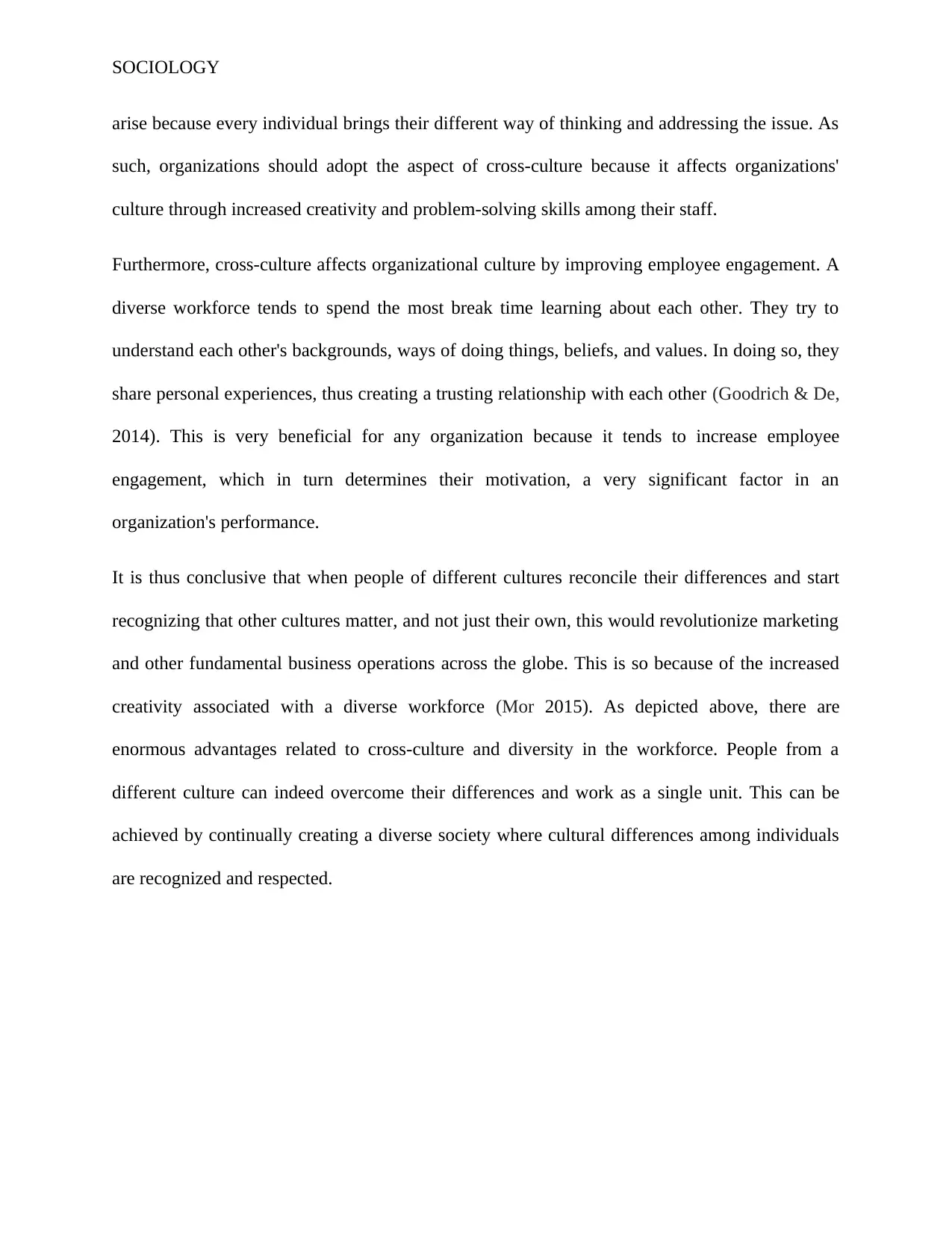
SOCIOLOGY
arise because every individual brings their different way of thinking and addressing the issue. As
such, organizations should adopt the aspect of cross-culture because it affects organizations'
culture through increased creativity and problem-solving skills among their staff.
Furthermore, cross-culture affects organizational culture by improving employee engagement. A
diverse workforce tends to spend the most break time learning about each other. They try to
understand each other's backgrounds, ways of doing things, beliefs, and values. In doing so, they
share personal experiences, thus creating a trusting relationship with each other (Goodrich & De,
2014). This is very beneficial for any organization because it tends to increase employee
engagement, which in turn determines their motivation, a very significant factor in an
organization's performance.
It is thus conclusive that when people of different cultures reconcile their differences and start
recognizing that other cultures matter, and not just their own, this would revolutionize marketing
and other fundamental business operations across the globe. This is so because of the increased
creativity associated with a diverse workforce (Mor 2015). As depicted above, there are
enormous advantages related to cross-culture and diversity in the workforce. People from a
different culture can indeed overcome their differences and work as a single unit. This can be
achieved by continually creating a diverse society where cultural differences among individuals
are recognized and respected.
arise because every individual brings their different way of thinking and addressing the issue. As
such, organizations should adopt the aspect of cross-culture because it affects organizations'
culture through increased creativity and problem-solving skills among their staff.
Furthermore, cross-culture affects organizational culture by improving employee engagement. A
diverse workforce tends to spend the most break time learning about each other. They try to
understand each other's backgrounds, ways of doing things, beliefs, and values. In doing so, they
share personal experiences, thus creating a trusting relationship with each other (Goodrich & De,
2014). This is very beneficial for any organization because it tends to increase employee
engagement, which in turn determines their motivation, a very significant factor in an
organization's performance.
It is thus conclusive that when people of different cultures reconcile their differences and start
recognizing that other cultures matter, and not just their own, this would revolutionize marketing
and other fundamental business operations across the globe. This is so because of the increased
creativity associated with a diverse workforce (Mor 2015). As depicted above, there are
enormous advantages related to cross-culture and diversity in the workforce. People from a
different culture can indeed overcome their differences and work as a single unit. This can be
achieved by continually creating a diverse society where cultural differences among individuals
are recognized and respected.
⊘ This is a preview!⊘
Do you want full access?
Subscribe today to unlock all pages.

Trusted by 1+ million students worldwide
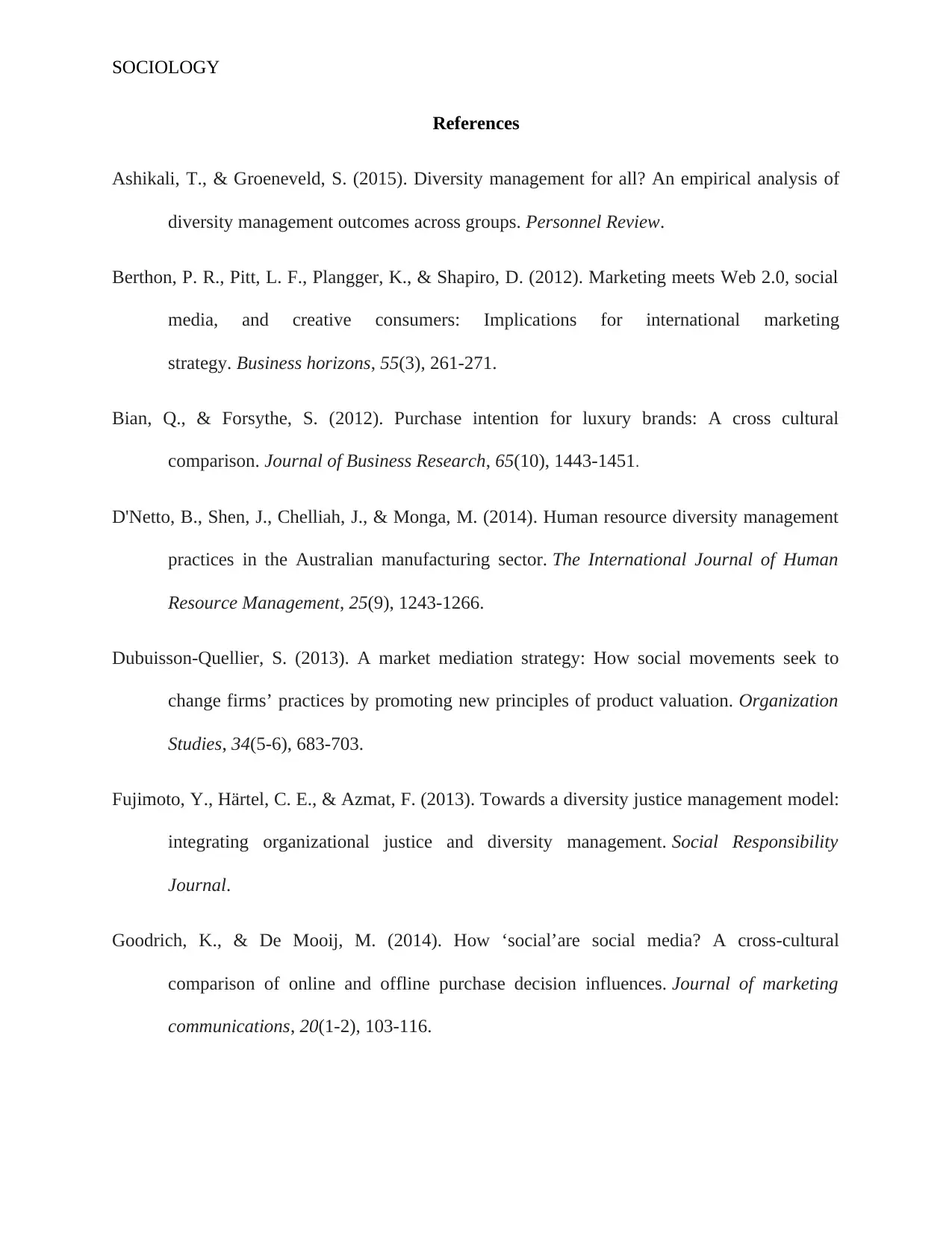
SOCIOLOGY
References
Ashikali, T., & Groeneveld, S. (2015). Diversity management for all? An empirical analysis of
diversity management outcomes across groups. Personnel Review.
Berthon, P. R., Pitt, L. F., Plangger, K., & Shapiro, D. (2012). Marketing meets Web 2.0, social
media, and creative consumers: Implications for international marketing
strategy. Business horizons, 55(3), 261-271.
Bian, Q., & Forsythe, S. (2012). Purchase intention for luxury brands: A cross cultural
comparison. Journal of Business Research, 65(10), 1443-1451.
D'Netto, B., Shen, J., Chelliah, J., & Monga, M. (2014). Human resource diversity management
practices in the Australian manufacturing sector. The International Journal of Human
Resource Management, 25(9), 1243-1266.
Dubuisson-Quellier, S. (2013). A market mediation strategy: How social movements seek to
change firms’ practices by promoting new principles of product valuation. Organization
Studies, 34(5-6), 683-703.
Fujimoto, Y., Härtel, C. E., & Azmat, F. (2013). Towards a diversity justice management model:
integrating organizational justice and diversity management. Social Responsibility
Journal.
Goodrich, K., & De Mooij, M. (2014). How ‘social’are social media? A cross-cultural
comparison of online and offline purchase decision influences. Journal of marketing
communications, 20(1-2), 103-116.
References
Ashikali, T., & Groeneveld, S. (2015). Diversity management for all? An empirical analysis of
diversity management outcomes across groups. Personnel Review.
Berthon, P. R., Pitt, L. F., Plangger, K., & Shapiro, D. (2012). Marketing meets Web 2.0, social
media, and creative consumers: Implications for international marketing
strategy. Business horizons, 55(3), 261-271.
Bian, Q., & Forsythe, S. (2012). Purchase intention for luxury brands: A cross cultural
comparison. Journal of Business Research, 65(10), 1443-1451.
D'Netto, B., Shen, J., Chelliah, J., & Monga, M. (2014). Human resource diversity management
practices in the Australian manufacturing sector. The International Journal of Human
Resource Management, 25(9), 1243-1266.
Dubuisson-Quellier, S. (2013). A market mediation strategy: How social movements seek to
change firms’ practices by promoting new principles of product valuation. Organization
Studies, 34(5-6), 683-703.
Fujimoto, Y., Härtel, C. E., & Azmat, F. (2013). Towards a diversity justice management model:
integrating organizational justice and diversity management. Social Responsibility
Journal.
Goodrich, K., & De Mooij, M. (2014). How ‘social’are social media? A cross-cultural
comparison of online and offline purchase decision influences. Journal of marketing
communications, 20(1-2), 103-116.
Paraphrase This Document
Need a fresh take? Get an instant paraphrase of this document with our AI Paraphraser
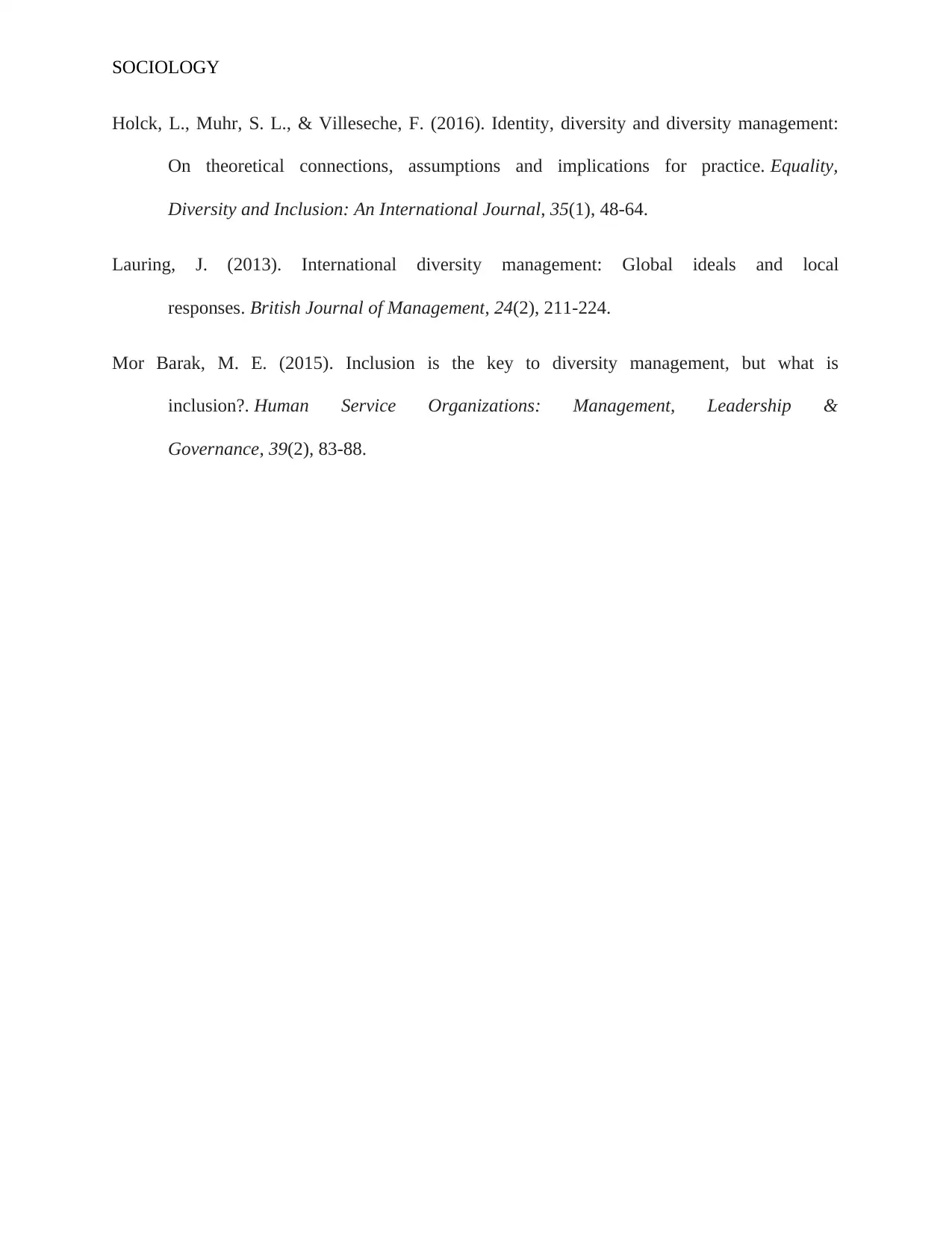
SOCIOLOGY
Holck, L., Muhr, S. L., & Villeseche, F. (2016). Identity, diversity and diversity management:
On theoretical connections, assumptions and implications for practice. Equality,
Diversity and Inclusion: An International Journal, 35(1), 48-64.
Lauring, J. (2013). International diversity management: Global ideals and local
responses. British Journal of Management, 24(2), 211-224.
Mor Barak, M. E. (2015). Inclusion is the key to diversity management, but what is
inclusion?. Human Service Organizations: Management, Leadership &
Governance, 39(2), 83-88.
Holck, L., Muhr, S. L., & Villeseche, F. (2016). Identity, diversity and diversity management:
On theoretical connections, assumptions and implications for practice. Equality,
Diversity and Inclusion: An International Journal, 35(1), 48-64.
Lauring, J. (2013). International diversity management: Global ideals and local
responses. British Journal of Management, 24(2), 211-224.
Mor Barak, M. E. (2015). Inclusion is the key to diversity management, but what is
inclusion?. Human Service Organizations: Management, Leadership &
Governance, 39(2), 83-88.
1 out of 8
Related Documents
Your All-in-One AI-Powered Toolkit for Academic Success.
+13062052269
info@desklib.com
Available 24*7 on WhatsApp / Email
![[object Object]](/_next/static/media/star-bottom.7253800d.svg)
Unlock your academic potential
Copyright © 2020–2025 A2Z Services. All Rights Reserved. Developed and managed by ZUCOL.





